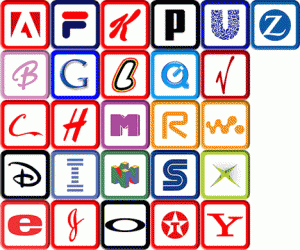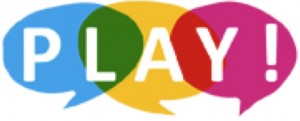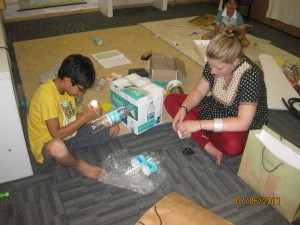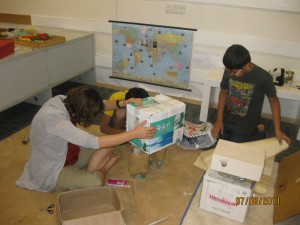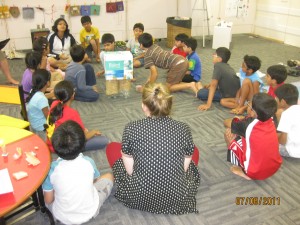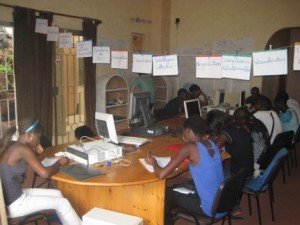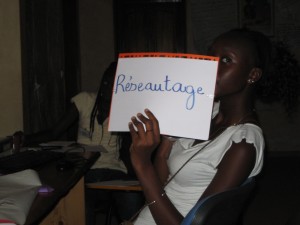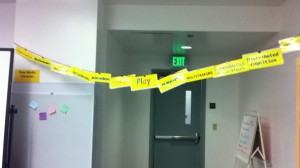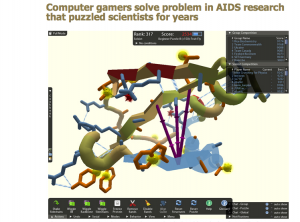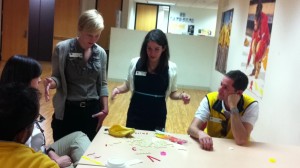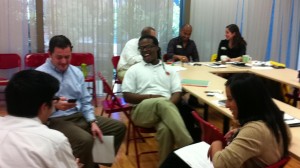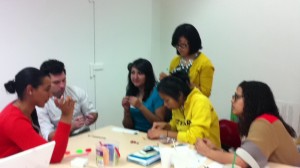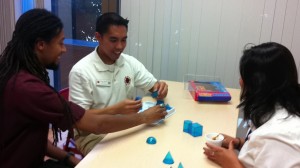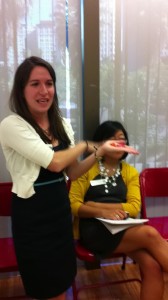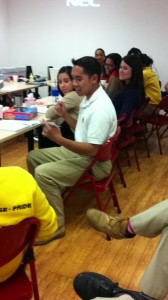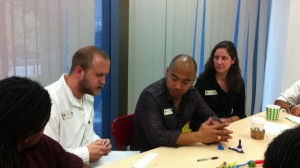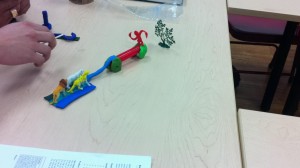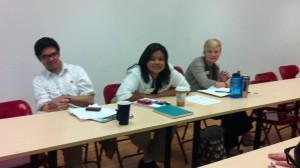“Digital equity is the social-justice goal of ensuring that everyone in our society has equal access to technology tools, computers and the Internet. Even more, it is when all
individuals have the knowledge and skills to access and use technology tools, computers and the Internet”
(International Society for Technology in Education (ISTE) Digital Equity Toolkit – Working Draft, 2006).
Nora Fleming recently queried me on digital equity. After writing back an extremely long response (see Q’s and A’s), I decided to plunge deeper — and probably more responsibly — into Nora’s specific area of interest and the work that she previously has done to that end. I wish I had done this digging first — and I hope any/all readers will do as I say, not as I did; from this point forward, I will do my homework first and pontificate last. Lesson learned.
So today I searched for a definition of digital equity and, to my relief, it is as I had conjectured — a state in which both the digital divide and the participation gap are bridged. I wonder if the term digital equity has fallen out of favor, as the definition and other articles I found that used this verbiage were not current; indeed, the piece I cite above (a working draft at that!) is six years old, which is a lifetime in the digital realm. If this is indeed the case, then Nora might want to consider adopting a more relevant label.
I would argue for a different term in any case because I’m wary of limiting our scope to just digital. Do we really wish to focus exclusively on the digital, I wonder — just 1’s and 0’s, only what’s written on microchips? Is that the characteristic of interest? Or do we wish to consider media and communication more broadly? This would encompass beneath its wide umbrella all things digital, as well as information products and communication processes that qualify as analog. Rather than digital equity, then, perhaps we need to call for communication equity... That doesn’t sound as catchy but maybe it’ll catch on…
I read Nora’s 6 November 2012 article, Schools Are Using Social Networking to Involve Parents, and was struck by a number of things. First, Nora already knows a lot of what I spewed in last night’s email. In fact, she had a few things to teach me; all the way from Washington, DC, she discovered and reported that I have a colleague in my backyard: “Wendy Lazarus, the chief executive officer and co-founder of The Children’s Partnership, a Santa Monica, Calif.-based nonprofit that helped launch a school-based digital education initiative for parents in the Los Angeles area several years ago” (Fleming, 2012, para 28). Overall, I found this article extremely interesting and full of useful information.
If I were to offer any constructive critique, it would be to consider some of the (1) human, (2) professional, (3) commercial, and (4) environmental impacts of this pursuit of equity. Often, good-intentioned interventions fail to deliver unqualified benefits — or even any benefits at all — where these dimensions are concerned.
1. Human
In terms of human impacts, I would challenge us to consider the toll that unremitting digital access can exact. According to Michael Searson, the executive director for the School for Global Education and Innovation at Kean University in Union, N.J., and the president of the Society for Information Technology and Teacher Education, “It’s unethical to provide a robust digital learning program in school for kids who don’t have access in their bedrooms and family rooms. As schools begin to integrate mobile devices and social media into education, the out-of-school equity issues have to be considered. Education leaders need to understand equity is not only access to devices, but access to the networks that allow people to get information” (cited in Fleming, 2012, para 38).
I disagree with the first part of Searson’s argument. A robust digital learning program can certainly be utilized in classrooms, and skilled educators there can help their students to scaffold their development of digital/new media literacies. It’s unfair to expect students to work on digital projects at home if they don’t have digital access at home — I agree with that. But what are the ethical implications of working towards online access in kids’ bedrooms and family rooms? The body of research on televisions in children’s bedrooms demonstrates that the presence of this media fount is correlated with impaired sleep (e.g., see this most recent write-up of a study from the University of Alberta). Humans need sleep. Humans need respites from any given activity, and certainly from more passively-oriented, visually stimulating activities. I happen to find it unethical to introduce powerful technologies into sensitive contexts, such as children’s bedrooms and families’ spaces for togetherness, without thoughtful, deliberate processes for establishing boundaries, and without offering some sample guidelines for reference and remixing.
Without these conversations and limits, some (most?) folks will struggle to appropriately portion control and will inevitably overuse. They’ll send infinite messages, spend excessive amounts of time managing Inboxes, bury their noses in their smartphones whenever there’s a lull in the action, and keep their mobile device at their bedsides, to jar them from sleep when an email comes in and to consult with immediately upon waking. We all know people like that, don’t we? And we cannot dismiss them all as addicts run amok, slaves to frivolity.
2. Professional
My partner, for example, is one of these embattled individuals. He’s accountable to notices that beep their way into his iPhone (which he pays for himself) at all hours of the day and night. I plead with him to just turn it off, but it’s not that simple. If Mike doesn’t react to the communique, he’ll soon hear about it from his boss in three other mediated ways (e.g., text, phone call, skywriting). And it’s not as easy as sitting down with his boss and saying, “Ease up.” If they institute a company policy to ignore the late-night notices, then another company will scoop up the notices’ embedded opportunities. Then this other company’s clients will ultimately land the jobs that will help them feed their families — these other company’s clients, not his. And Mike’s clients have hungry families too.
So we have a systemic issue here, which requires an industry-wide solution, perhaps a multi-industry solution, to give adequate amounts of time during the workday for the execution of professional labor, and to recognize that a limited workday does exist — all time does not equal work time. As Jeff Goldblum’s character in Jurassic Park reminded us, Just because we can [in this case, work around the clock], doesn’t meant that we should. And arguably, we can’t — see my humanness argument above.
These rules and realizations extend to teachers and parents too. They deserve a manageable slate of tasks and expectations so that they aren’t consistently set up to fail, and/or internalize the sense that they’re always falling short. In her article, Nora explained “Mr. Vodicka [Superintendent of Vista, CA] started a Twitter account and began making the rounds to schools, with the goal of reaching every classroom in the district and tweeting his experiences at each to his Twitter followers. Other administrators in the district have followed Mr. Vodicka’s lead—now, 60 administrators have school-related Twitter and Facebook accounts, and around three-quarters of the schools now have some kind of social-media presence” (Fleming, 2012, para 18).
I applaud this administrator’s transparency and accessibility. But I worry about the implicit — or explicit — demands this introduces for his staff and the parents in his district. Avoiding Twitter could frame teachers and parents as less conscientious, less communicative, and/or less contemporary than they should be. This is unfair since attending to Twitter and other social media accounts doesn’t come from a vast wasteland of time — teachers and parents aren’t thumb-twiddling, they’re phenomenally busy. So how does introducing accountability to social media add more (unpaid) labor to already teeming job descriptions ? And how does this detract, if at all, from quality of life and family time?
3. Commercial
In terms of commercial impacts, I’m wary of private enterprises’ encroachment into public domains. I studied commercialism in schools when I was working towards my Master’s degree in Child Development, and I worry about the growing prevalence of commercial messages in taxpayer-funded spaces, especially those frequented by youths. Some people say that these partnerships are win-win; for example, when as a kid I participated in Book It!, I was encouraged to read and rewarded with free personal pan pizza. But was this less of a win for reading, which arguably should be intrinsically motivated in order to sustain lifelong engagement, and more of a win for Pizza Hut (since only my meal was comped, not my brother’s, sister’s, mom’s, or dad’s)?
Nora wrote, “With donations from the Microsoft Corp. as well as $25,000 from the local school endowment, the district created “parent super centers” on five school campuses” in Houston. I appreciate this, but I can’t help but notice the business opportunity in this “philanthropy” which brands it as much, if not more, of a PR endeavor and chance to establish a brand relationship with a new market of consumers. Computers for Youth facilitates the receipt of a refurbished, personal computer by parent enrollees of computer training workshops; they also guide parents in how to get broadband Internet in their homes, which they can typically access at highly discounted rates (Fleming, 2012). Again, I appreciate this assistance, especially in terms of negotiating the complicated processes of subscribing for services and obtaining low-income discounts. But which company’s computers are they distributing? Which internet service providers are they promoting? How, if at all, do non-profit and public institutions operate as middlemen for multinational corporations, and what is the net benefit for citizens?
4. Environmental
In terms of environmental impact, let me back up and say, I had the good fortune of studying political economy with Dr. Ellen Seiter. In her course, we read Vincent Mosco’s The Digital Sublime, an eye-opening look at how increased digital consumption via personal devices contributes to inhumane labor conditions, massive amounts of e-waste, and dangerous scavenging through these mountains of chemical-dripping refuse by folks desperate for income.
Some research also identifies how increased demand for tin, tungsten, and tantalum — the elements that power our digital devices — has transformed them into “conflict minerals.” Like “conflict diamonds” (made famous by the 2006 film Blood Diamond), pursuit of these minerals has inspired brutal conflicts between rival militias in eastern Africa, resulting in widespread slaughter and rape (for a dramatized explanation of this situation, see Law & Order: SVU’s 2010 episode “Witness,” written by Dawn DeNoon; an analysis of this episode’s impact, written by Sheila Murphy, Heather J. Heather, Sandra de Castro Buffington, and myself will be published in a forthcoming edition of The American Journal of Media Psychology).
Mosco also challenges us to consider how, if at all, this increased access to information (some of it credible, some of it spurious, and few of us able to distinguish the difference), and increased access to communication (some of it useful, some of it banal, and few of us able to control our predominant engagement with the former), actually makes our lives better. It undoubtedly does sometimes, but not always. So should our goal be to increase round-the-clock access universally, or to identify the qualities of and conditions under which more information and communication delivers benefit?
My belief: the latter. Let’s identify the qualities of and conditions under which more information and communication delivers benefit. This will help us to recognize when it better serves us to disconnect from the screen and plug in to each other. And this will imply a less drastic product-fix: not a portal in every bedroom, necessarily, or always-on internet, but household access, peak hour availability.
As we struggle for equity, we must simultaneously fight for humanity.




